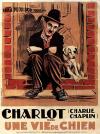Poor Charlie is out of a job and his
prospects are dim. He tries to filch some food from a lunch cart and is
almost caught by a policeman. He has to do some fancy rolling back and forth
underneath a fence to avoid the clutches of the law. Later on, Charlie saves
a roving dog named Scraps from some other dogs, and the two become friends
as well as partners in purloining food.
When Charlie goes into a cabaret where Scraps would not be allowed, he hides the
dog in his baggy trousers. Scraps' tail emerges from a hole in the back of
Charlie's trousers and this makes the man a sight to see. Charlie meets a girl
who works in the cabaret and tries to cheer her up when he discovers that she is
disillusioned with life.
When Charlie's lack of money causes
him to be thrown out of the cabaret, he returns to his open-air sleeping spot,
unaware that crooks have buried a wallet there. Scraps digs it up, covering
Charlie's face with dirt in the process. Charlie finds money in the wallet and
takes it to the cabaret to show the girl that there is enough for them to get
married on. The crooks who buried the wallet spot Charlie and take back the
stolen booty with some violence. Charlie battles to get it back. This leads to a
chase which ends with the arrest of the crooks. Charlie and the girl marry and
use the money to buy a farm. There they are seen looking fondly into a cradle
which contains Scraps and her puppies.
Working under a million-dollar
contract, this was Chaplin's first film for First National, a company which
later merged with Warner Brothers. Most of Chaplin's Mutual Company actors
continued in his new films, but some new additions were made to the troupe,
including his brother, Sydney.
What was said about
A Dog's Life:

Los Angeles Examiner (Florence
Lawrence)
Of course Chaplin uses his same funny hat and mustache. These, like the wide
trousers and strategic shoes, are part of his personality so far as the public
is concerned, and a Chaplin comedy without them would be like Hamlet with the
mad prince emitted from the cast. But the star no longer depends upon his
grotesque attire for his laugh. He shows us in this film some of the marvelous
pantomime work for which his stage repute was high before films claimed him. In
the scene of the stolen money he performs with his hands, which prove quite as
capable at evoking laughs as ever his feet have been.
Chicago News (W. K. Hollander)
While Chaplin was in action loud guffaws of laughter greeted his comic capers. They laughed at his vulgarities―Chaplin does not deport himself entirely above
reproach―and applauded his nimbleness. He is admirably assisted by a remarkable
canine which imitated its master's morbid and drowsy facial expression so well
that one concludes it is a sort of Chaplin of the dog family. This considerably
adds to the fun. This dog furnishes the reason for the specialty and inspires an
exhilarating dog chase wherein Chaplin with the canine in his arms assumes the
undignified role of the pursued with a motley pack of hounds behind him.
It is a
strenuous chase, particularly for the comedian, for often the dogs meet up with
him and bury their teeth into the tail end of his coat, hanging on until part of
it gives away. But Charles―not Charlie now―emerges triumphantly with the dog in
his arms. Chaplin puts a new dress on some old tricks and renders several comic
novelties as well. Above all, Chaplin is without―yes, it's true―his familiar
cane. He accomplishes his various stunts unassisted by his adjunct of previous
activities. In lieu of the stick he leads his pup about by a rope.
